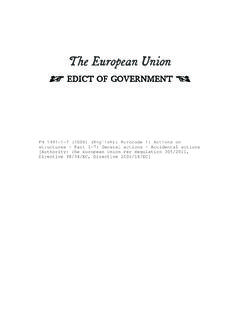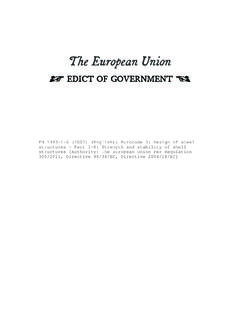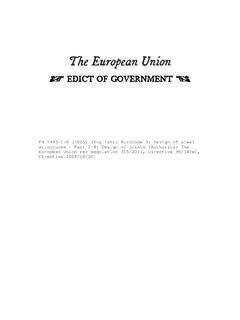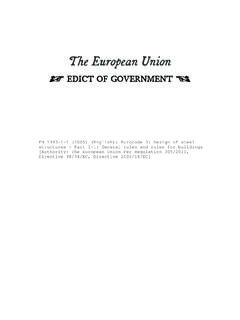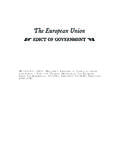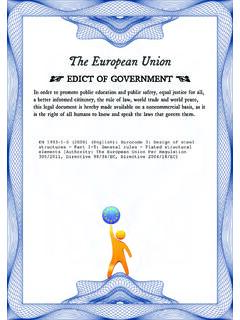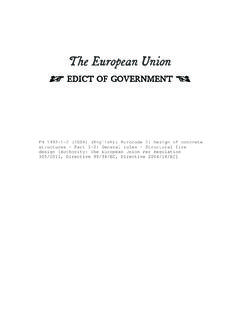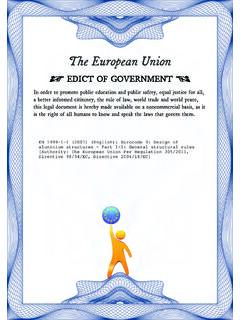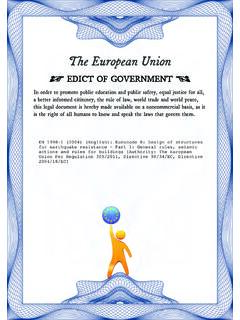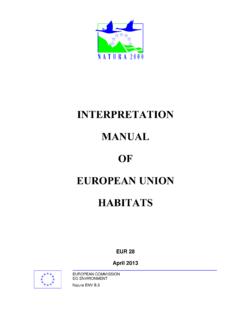Transcription of EN 1991-1-5: Eurocode 1: Actions on structures - Part 1-5 ...
1 The European UnionIn order to promote public education and public safety, equal justice for all, a better informed citizenry, the rule of law, world trade and world peace, this legal document is hereby made available on a noncommercial basis, as it is the right of all humans to know and speak the laws that govern them. EDICT OF GOVERNMENT EN 1991-1-5 (2003) (English): Eurocode 1: Actions onstructures - Part 1-5: General Actions - Thermal Actions [Authority: The European Union Per Regulation 305/2011,Directive 98/34/EC, Directive 2004/18/EC]EUROPEAN STANDARD NORMEEUROPEENNE EUROP)\ISCHE NORM EN 1991-1-5 November2003 Supersedes ENV 1991-2-5: 1997 Incorporating corrigendum March 2009 English version Eurocode 1: Actions on structures -Part 1-5: General Actions -Thermalactions Eurocode1 :Actionssurlesstructures-Partie1-5:Actio ns ne ralesActionsthermiques ThisEuropeanStandardwasapprovedbyCENon18 September2003.
2 CEN members are bound to comply with the CEN/CENELEC Internal Regulations which stipulate the conditions for giving this European Standard the status of a national standard without any alteration. Up-to-date lists and bibliograprlical references concerning such national standards may be obtained on application to the Management Centre or to any CEN member. This European Standard exists in three official versions (English, French, German). A version in any other language made by translation under the responsibility of a CEN member into its own language and notified to the Management Centre has the same status as the official versions. CEN members are the national standards bodies of Austria, Belgium, Czech Republic, Denmark, Finland, France, Germany, Greece, Hungary, Iceland, Ireland, Italy, Luxembourg, Malta, Netherlands, Norway, Portugal, Slovakia, Spain, Sweden, Switzerland and United Kingdom.
3 EUROPEAN COMMIlTEE FOR STANDARDIZATION COMITE EUROPEEN DE NORMALISATION EUROpA lSCHES KOMITEE FUR NORMUNG Management Centre: rue de Stassart, 36 B-1050 Brussels 2003 CEN All rights of exploitation in any form and by any means reserved worldwide for CEN national Members. :2003E BS EN 1991,-1-5: 2003 EN 1991-1-5: 2003 (E) CONTENTS Page FOREWORD .. 4 BACKGROUND TO THE Eurocode PROGRAMME .. 4 STATUS AND FIELD OF APPLICATION OF EUROCODES .. 5 NATIONAL STANDARDS IMPLEMENTING EUROCODES .. 6 LINKS BETWEEN EUROCODES AND PRODUCT HARMONIZED TECHNICAL SPECIFICATIONS (ENs AND ETAs) .. 6 ADDITIONAL INFORMATION SPECIFIC TO EN 1991-1-5 .. 6 NATIONAL ANNEX FOR EN 1991-1-5 .. 7 SECTION 1 GENERAL .. 8 SCOPE .. 8 NORMATIVE REFERENCES .. 8 ASSUMPTIONS .. 8 DISTINCTION BETWEEN PRINCIPLES AND APPLICATION RULES .. 9 DEFINITIONS .. 9 SYMBOLS .. 10 SECTION 2 CLASSIFICATION OF Actions .
4 13 SECTION 3 DESIGN SiTUATIONS .. 14 SECTION 4 REPRESENTATION OF Actions .. 15 SECTION 5 TEMPERATURE CHANGES IN BUiLDINGS .. 17 GENERAL .. 17 DETERMINATION OF TEMPERATURES .. 17 DETERMINATION OF TEMPERATURE PROFILES .. 18 SECTION 6 TEMPERATURE CHANGES IN BRIDGES .. 20 BRIDGE DECKS .. 20 6. 1. 1 Bridge deck types .. 20 6. Consideration of thermal Actions .. 20 Uniform temperature component .. 20 Temperature difference components .. 24 6. Simultaneity of uniform and temperature difference components .. 30 6. Differences in the uniform temperature component between different structural elements .. 31 BRIDGE PiERS .. 31 Consideration of thermal Actions .. 31 Temperature differences .. 31 SECTION 7 TEMPERATURE CHANGES IN INDUSTRIAL CHIMNEYS, PIPELINES, SILOS, TANKS AND COOLING TOWERS .. 32 GENERAL .. 32 TEMPERATURE COMPONENTS .. 32 Shade air temperature.
5 32 Flue gas, heated liquids and heated materials temperature .. 33 2 BS EN 1991 .. 1-5: 2003 EN 1991-1-5: 2003 (E) Element temperature .. 33 CONSIDERATION OF TEMPERATURE COMPONENTS .. 33 DETERMINATION OF TEMPERATURE COMPONENTS .. 33 VALUES OF TEMPERATURE COMPONENTS (INDICATIVE VALUES) .. 34 SIMULTANEITY OF TEMPERATURE COMPONENTS .. 34 ANNEX A (NORMATIVE) ISOTHERMS OF NATIONAL MINIMUM AND MAXIMUM SHADE AIR TEMPERATURES .. 36 GENERAL .. 36 MAXIMUM AND MINIMUM SHADE AIR TEMPERATURE VALUES WITH AN ANNUAL PROBABILITY OF BEING EXCEEDED P OTHER THAN 0,02 .. 36 ANNEX B (NORMATIVE) TEMPERATURE DIFFERENCES FOR VARIOUS SURFACING DEPTHS .. 39 ANNEX C (INFORMATIVE) COEFFICIENTS OF LINEAR EXPANSION .. 42 ANNEX D (INFORMATIVE) TEMPERATURE PROFILES IN BUILDINGS AND OTHER CONSTRUCTION WORKS .. 44 BIBLIOGRAPHY .. 46 3 BS EN 1991-1-5: 2003 EN 1991-1-5: 2003 (E) Foreword This document (EN 1991-1-5) has been prepared by Technical Committee CEN/TC250 "Structural Eurocodes", the secretariat of which is held by BSI.
6 This European Standard shall be given the status of a national standard, either by publication of an identical text or by endorsement, at the latest by May 2004, and conflicting national standards shall be withdrawn at the latest by March 2010. Annexes A and B are normative. Annexes C and D are informative. This document supersedes ENV 1991-2-5: 1997. According to the CEN/CENELEC Internal Regulations, the national standards organizations of the following countries are bound to implement this European Standard: Austria, Belgium, Czech Republic, Denmark, Finland, France, Germany, Greece, Hungary, Iceland, Ireland, Italy, Luxembourg, Malta, Netherlands, Norway, Portugal, Slovakia, Spain, Sweden, Switzerland and the United Kingdom. Background to the Eurocode Programme In 1975, the Commission of the European Comn1unities decided on an action programme in the field of construction, based on article 95 of the treaty.
7 The objective of the programme was the elimination of technical obstacles to trade and the harmonization of technical specifications. Within this action programme, the Commission took the initiative to establish a set of harmonised technical rules for the design of construction works which, in a first stage, would serve as an alternative to the national rules in force in the Member States and, ultimately, would replace them. For fifteen years, the Commission, with the help of a Steering Committee with Representatives of Member States, conducted the development of the Eurocodes programme, which led to the first generation of European codes in the 1980's. In 1989, the COfTIrTlission and the Member States of the EU and EFTA decided, on the basis of an agreement between the Commission and CEN, to transfer the preparation and the publication of the Eurocodes to CEN through a series of mandates, in order to provide them with a future status of European Standard (EN).
8 This links de facto the Eurocode with the provisions of all the Council's Directives and/or Commission's Decisions dealing with European Standards ( the Council Directive 89/106/EEC on construction products - CPD - and Council Directives 93/37/EEC, 92/50/EEC and 89/440/EEC on public works and services and equivalent EFTA Directives initiated in pursuit of settings up the internal market). The Structural Eurocode prograrTlme comprises the following standards generally consisting of a number of Parts: 4 BS EN 1991-1-5: 2003 EN 1991-1-5: 2003 (E) EN 1990 EN 1991 EN 1992 EN 1993 EN 1994 EN 1995 EN 1996 EN 1997 EN 1998 EN 1999 Eurocode : Eurocode 1: Eurocode 2: Eurocode 3: Eurocode 4: Eurocode 5: Eurocode 6: Eurocode 7: Eurocode 8: Eurocode 9: Basis of Structural Design Actions on structures Design of concrete structures Design of steel structures Design of composite steel and concrete structures Design of timber structures Design of nlasonry structures Geotechnical design Design of structures for earthquake resistance Design of aluminium alloy structures Eurocode standards recognize the responsibility of regulatory authorities in each Member State and have safeguarded their right to determine values related to regulatory safety matters at national level where these continue to vary from State to State.
9 Status and field of application of Eurocodes The Member States of the EU and EFTA recognize that Eurocodes serve as reference documents for the following purposes: as a means of providing compliance of building and civil engineering works with the essential requirements of Council Directive 89/106/EEC, particularly Essential Requirenlent N 1 - Mechanical resistance and stability - and Essential Requirement N 2 - Safety in case of fire; -as a basis for specifying contracts for construction works and related engineering services; -as a framework for drawing up harmonized technical specifications for construction products (ENs and ETAs) The Eurocodes, as far as they concern the construction works themselves, have a direct relationship with the Interpretative Documents referred to in Article 12 of the CPD, although they are of a different nature from harmonized product standards.
10 Therefore, technical aspects arising from the Eurocodes work need to be adequately considered by CEN Technical Committees and/or EOTA Working Groups working on product standards with a view to achieving a full compatibility of these technical specifications with the Eurocodes. The Eurocode standards provide common structural design rules for everyday use for the design of whole structures and component products of both a traditional and an innovative nature. Unusual forms of construction design conditions are not specifically covered and additional expert consideration will be required by the designer in such cases. 5 BS EN 1991 1 5: 2003 EN 1991-1-5: 2003 (E) National Standards implementing Eurocodes The National Standards implementing Eurocodes will comprise the full text of the Eurocode (including any annexes), as published by CEN, which may be preceded by a National title page and National foreword, and may be followed by a National annex (informative ).
